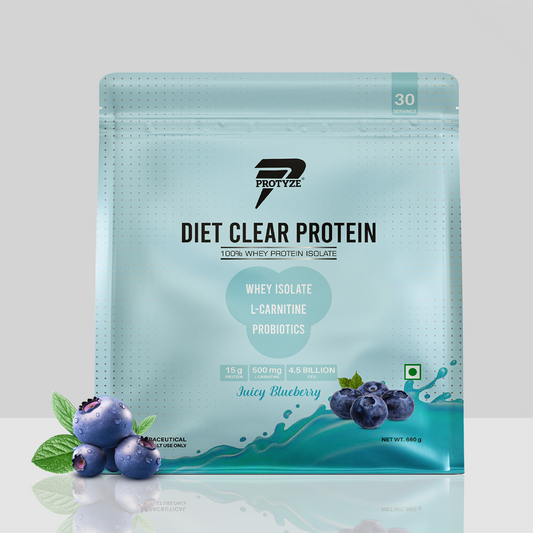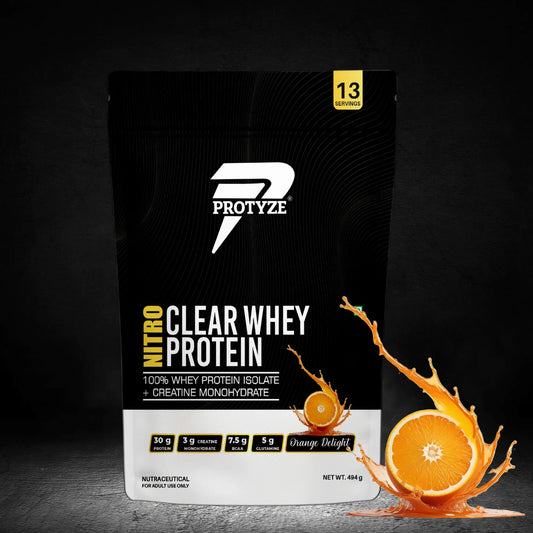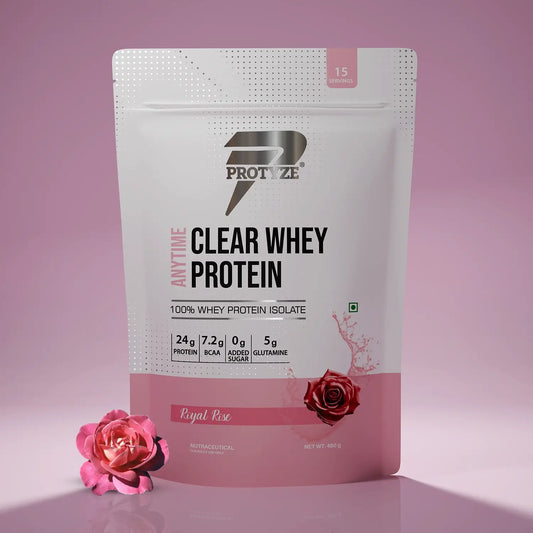Purines are natural compounds found in certain foods that, when broken down, produce uric acid in the body. While purines are essential for cellular function, a diet high in purine-rich foods can lead to excessive uric acid, causing health issues like gout, kidney stones, or joint discomfort. Recognizing the signs of too much purine in your diet is key to preventing these problems and maintaining wellness.
This blog outlines 10 signs your diet has too much purine, explains their implications, and offers strategies to adopt a low-purine lifestyle. We’ll also highlight Protyze Diet Clear Whey, a low-calorie, low-purine protein supplement, to support your health-focused diet.
Understanding Purines and Their Impact
Purines are present in foods like red meat, seafood, and legumes, as well as produced by the body during cell turnover. When metabolized, they form uric acid, which the kidneys typically excrete. However, a diet high in purines—often from frequent consumption of foods like liver or sardines—can overwhelm this process, leading to uric acid buildup.
This can result in painful conditions, inflammation, or metabolic challenges, particularly for those with a genetic predisposition or high-protein diets. Identifying the signs of excessive purine intake allows you to adjust your diet and lifestyle to prevent complications.
Top 10 Signs Showing Your Diet Has Too Much Purine
Mentioned Below are some of the Signs that will indicate you are having too much of Purine:
1. Joint Pain and Swelling

Excessive purine intake can cause uric acid crystals to form in joints, leading to sharp, throbbing pain and swelling, often in the big toe, knees, or ankles. This is a hallmark of gout, a condition triggered by high uric acid levels. The discomfort may come and go, worsening after eating purine-rich foods like red meat or shellfish, making it a clear signal to reassess your diet.
Implication
- Persistent joint pain can limit mobility and affect daily activities.
Action
- Reduce purine-heavy foods and consult a healthcare provider if pain persists.
2. Frequent Gout Flare-Ups

If you experience recurring episodes of intense joint pain, redness, and warmth, your diet may be too high in purines. Gout flare-ups occur when uric acid levels spike, often after consuming foods like organ meats or alcohol. These episodes can last days or weeks, disrupting your routine and signaling a need for dietary changes.
Implication
- Repeated flare-ups may lead to chronic gout, causing lasting joint damage.
Action
- Limit high-purine foods and increase hydration to flush uric acid.
3. Kidney Stones or Painful Urination

High uric acid from a purine-rich diet can form crystals in the kidneys, leading to kidney stones. You may notice sharp pain in the lower back or abdomen, difficulty urinating, or blood in the urine. These symptoms suggest your diet, possibly high in foods like sardines or lentils, is overloading your kidneys with purines.
Implication
- Kidney stones can cause severe pain and potential kidney damage if untreated.
Action
- Drink 2.5-3L water daily and switch to low-purine proteins like eggs.
4. Persistent Fatigue

A diet high in purines, especially when paired with foods like beef or beer, can strain the kidneys and contribute to systemic inflammation, leaving you feeling tired or sluggish. This fatigue may stem from the body’s effort to process excess uric acid, affecting energy levels and overall vitality.
Implication
- Chronic fatigue can reduce productivity and exercise capacity.
Action
- Incorporate low-purine, nutrient-rich foods like leafy greens and fruits.
5. Swollen or Tender Joints

Beyond gout, high purine intake can cause general joint tenderness or swelling, even without a formal diagnosis. You might feel stiffness or discomfort in your fingers, wrists, or elbows, particularly after eating purine-rich meals like shrimp or kidney beans. This subtle sign indicates uric acid accumulation in joints.
Implication
- Ongoing joint issues may progress to chronic inflammation.
Action
- Reduce purine intake and add anti-inflammatory foods like cherries.
6. Increased Thirst or Dehydration

A purine-heavy diet, especially with alcohol or processed foods, can dehydrate the body, concentrating uric acid in the blood. You may feel unusually thirsty or notice dry mouth, as your body struggles to excrete excess uric acid through urine. This dehydration exacerbates purine-related symptoms.
Implication
- Dehydration worsens uric acid buildup and kidney strain.
Action
- Hydrate with 2.5-3L water daily and limit alcohol consumption.
7. Digestive Discomfort or Bloating

High-purine foods, such as organ meats or legumes, can stress the digestive system, leading to bloating, gas, or discomfort, especially if consumed frequently. This may occur as the body processes purine-rich meals, signaling an imbalance in your diet that could contribute to uric acid issues.
Implication
- Digestive issues can disrupt nutrient absorption and comfort.
Action
- Choose low-purine, gut-friendly proteins like Protyze Diet Clear Whey, which offers 15g protein and probiotics in a 99% lactose-free formula, mixed with water.
8. Weight Gain or Difficulty Losing Weight

Purine-rich foods like red meat or beer are often calorie-dense, contributing to weight gain, which can increase uric acid production. If you’re struggling to lose weight despite efforts, your high-purine diet may be a factor, as excess body fat amplifies uric acid levels and related symptoms.
Implication
- Excess weight heightens gout and kidney stone risks.
Action
- Opt for low-purine, low-calorie options like Protyze Diet Clear Whey to support weight management and muscle maintenance.
9. Skin Irritation or Tophi

In severe cases, high uric acid from a purine-heavy diet can cause tophi—small, chalky lumps under the skin, often near joints or ears. These deposits, along with redness or irritation around affected areas, indicate chronic uric acid buildup, a serious sign of excessive purine intake.
Implication
- Tophi can cause discomfort and signal advanced gout.
Action
- Seek medical advice and drastically reduce purine-rich foods.
10. Frequent Urinary Issues

A diet high in purines can lead to uric acid crystals in the urinary tract, causing frequent urination, burning sensations, or cloudy urine. These symptoms suggest your kidneys are struggling to process excess uric acid, likely from foods like anchovies or spirits, and need dietary adjustments.
Implication
- Urinary issues can lead to infections or kidney damage if ignored.
Action
- Increase water intake and switch to low-purine proteins like tofu or dairy.
Managing a High-Purine Diet
If you notice these signs, adopting a low-purine diet and lifestyle changes can help reduce uric acid levels and alleviate symptoms. Here’s how to take control:
Identify and Limit High-Purine Foods
- Foods to Reduce: Red meat (100-200 mg purines/100g), organ meats (200-400 mg/100g), certain seafood (100-300 mg/100g), legumes (50-150 mg/100g), and alcohol (50-150 mg/330ml for beer).
- Strategies: Limit these to 1-2 servings monthly, keeping portions small (50-70g). Track your diet to pinpoint triggers for symptoms like joint pain or fatigue.
Incorporate Low-Purine Alternatives
- Proteins: Eggs, low-fat dairy, and tofu provide 10-20g protein per 100g with minimal purines (<50 mg). Protyze Diet Clear Whey (15g protein, 99% lactose-free, Juicy Mango flavor) mixed with water is a low-purine, probiotic-enhanced option for recovery and gut health.
- Vegetables: Cucumbers, zucchini, and carrots (0-20 mg purines/100g) add fiber and hydration.
- Fruits: Cherries, apples, and bananas are low-purine and support uric acid reduction.
- Grains: Rice, oats, and quinoa offer energy with negligible purines.
Balance Nutrition
- Protein Needs: Aim for 1.0-1.6g/kg body weight (60-110g for 70kg) using low-purine sources to support muscle health without purine overload.
- Carbohydrates and Fats: Include whole grains and healthy fats (e.g., olive oil, avocados) for satiety, keeping calories balanced (~1,800-2,000 kcal for maintenance).
- Gut Health: Probiotics ease digestive stress from high-purine foods, as seen in Protyze Diet Clear Whey’s formula.
Lifestyle Adjustments
- Hydration: Drink 2.5-3L water daily to dilute uric acid and support kidney function.
- Exercise: Engage in moderate activities like walking or yoga (30 min, 3-4x weekly) to maintain a healthy weight, as excess fat increases uric acid.
- Monitor Symptoms: Keep a journal of symptoms like joint pain or bloating to identify patterns and adjust your diet accordingly.
Conclusion
Recognizing the 10 signs your diet has too much purine—from joint pain and gout flare-ups to fatigue and kidney issues—empowers you to take charge of your health. High-purine foods like red meat, organ meats, seafood, legumes, and alcohol can elevate uric acid, leading to discomfort and complications. By switching to low-purine alternatives like eggs, low-fat dairy, and vegetables, and adopting habits like hydration and exercise, you can alleviate these symptoms. Protyze Diet Clear Whey, with its low-calorie, probiotic-enhanced, 99% lactose-free formula, provides a low-purine protein source to support recovery and gut health, fitting seamlessly into a health-conscious diet. Make informed choices and feel your best!
TL;DR
Too much purine in your diet can lead to high uric acid, causing joint pain, gout, kidney stones, fatigue, and digestive issues. Common culprits include red meat, seafood, organ meats, legumes, and alcohol. Key signs to watch for are joint swelling, fatigue, frequent urination, and skin irritation. Combat these by limiting high-purine foods, staying hydrated, exercising moderately, and switching to low-purine protein sources like eggs, tofu, and Protyze Diet Clear Whey—a 99% lactose-free, probiotic-rich, low-calorie protein drink. With simple changes and a balanced plan, you can reduce symptoms in 2–4 weeks and feel better.





